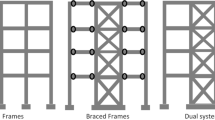Abstract
The present study seeks to couple the problem of the structural optimization of building frames, with that of the optimization of design options for their energy efficiency. The objective function is a cost function that takes into account both the structural cost and energy performance along the whole life of the building. Consequently, the following design parameters are involved: insulation thickness, wall and window insulation profile, window sizes, heating and air conditioning system sizing, sizing of steel cross-sections, as well as parameters related to the life cycle of the building. Modeling is based on acceptable from national and European regulations procedures. Optimization is solved using evolutionary algorithms. The optimization problem is implemented on a steel office building (\(10\times 15\) m), in Chania, Crete, at the south part of Greece. This is a first attempt to combine Life Cycle Cost and Optimization with classical Structural Optimization for steel structures. Depending on the requirements from the users of the building further evaluation using building energy management system (BEMS) for the intelligent operation and management of heating, ventilation and air-conditioning (HVAC) may be performed.
Access this chapter
Tax calculation will be finalised at checkout
Purchases are for personal use only
Similar content being viewed by others
References
Kaziolas DN, Zygomalas I, Stavroulakis GE, Emmanouloudis D, Baniotopoulos CC (2013) Evolution of environmental sustainability for timber and steel construction. In: Hakansson A, Häjer M, Howlett RJ, Jain LC (eds) Proceedings of the 4th international conference in sustainability in energy and buildings (SEB’12), 2013. Smart Innovation, Systems and Technologies, vol 22, pp 24–33
Kaziolas DN, Zygomalas I, Stavroulakis GE, Baniotopoulos CC (2013) Life cycle assessment of a steel-framed residential building. In: Topping BHV, Iványi P(eds) Proceedings of the fourteenth international conference on civil, structural and environmental engineering computing, 2013. Civil-Comp Press, Stirlingshire, UK, Paper 152. doi:10.4203/ccp.102.152
Stanford University: Land and Buildings (2005) Guidelines for life cycle cost analysis
Balaras CA (2011) Estimating energy consumption. National Observatory of Athens, Greece
BEES (Building for Environmental and Economic Sustainability) software homepage (2014) http://ws680.nist.gov/Bees/. Accessed May 2014
Technical Chamber of Greece (2010) T.O.T.E.E. 20701–1/2010 & T.O.T.E.E. 20701–2/2010. Athens, Greece
Technical Chamber of Greece (2012) T.O.T.E.E. 20701–3/2010. Athens, Greece
Cheng FY, Truman KZ (2010) Structural optimization: dynamic and seismic applications. Spon Press, USA
Bourkas PD (1998) Applications of building services in typical and industrial buildings. Dissertation, National Technical University of Athens, Greece, pp 214–233
Weber T et al (2004) The utilization factor for free heat in buildings: a statistical approach. KTH-The Royal Institute of Technology, Stockholm
Nielsen TR (2002) Optimization of buildings with respect to energy and indoor environment. Ph.D. Dissertation, Department of Civil Engineering, Technical University of Denmark, Denmark, pp 26–103
ISO 15686–5 (2008) Building and constructed assets—service life planning
Current German Energy Saving Regulations for Buildings (2014) EnEV 2014. Accessed March 2014
Minergie building energy design criteria (2014) http://www.minergie.ch/standard_minergie.html. Accessed March 2014
Passive house certification criteria (2014) http://www.passreg.eu/index.php?page_id=305. Accessed March 2014
Thomsen KE, Wittchen KB (2008) European national strategies to move towards very low energy buildings. Danish Building Research Institute, Aalborg University, Denmark
Acknowledgments
This research has been co-financed by the European Union (European Social Fund - ESF) and Greek national funds through the Operational Program "Education and Lifelong Learning" of the National Strategic Reference Framework (NSRF) - Research Funding Program: ARCHIMEDES III. Investing in knowledge society through the European Social Fund.
Author information
Authors and Affiliations
Corresponding author
Editor information
Editors and Affiliations
Appendix: Results of the Optimization Calculations 1
Appendix: Results of the Optimization Calculations 1
Rights and permissions
Copyright information
© 2015 Springer International Publishing Switzerland
About this chapter
Cite this chapter
Bekas, G.K., Kaziolas, D.N., Stavroulakis, G.E. (2015). Life Cycle Analysis and Optimization of a Steel Building. In: Lagaros, N., Papadrakakis, M. (eds) Engineering and Applied Sciences Optimization. Computational Methods in Applied Sciences, vol 38. Springer, Cham. https://doi.org/10.1007/978-3-319-18320-6_20
Download citation
DOI: https://doi.org/10.1007/978-3-319-18320-6_20
Published:
Publisher Name: Springer, Cham
Print ISBN: 978-3-319-18319-0
Online ISBN: 978-3-319-18320-6
eBook Packages: EngineeringEngineering (R0)




